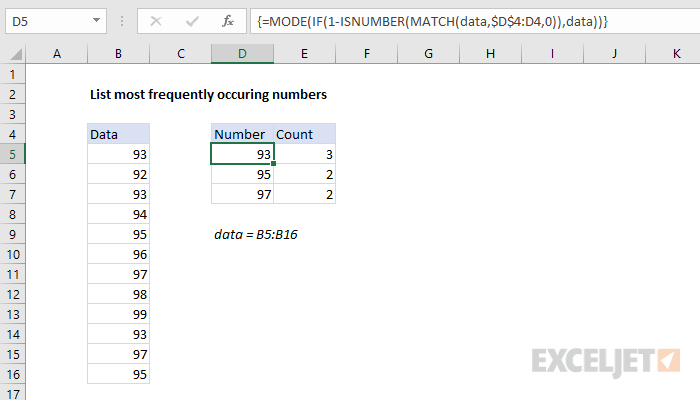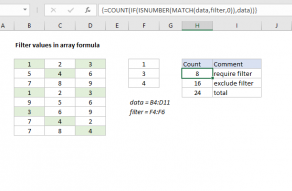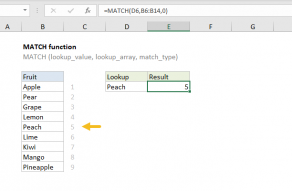Explanation
The core of this formula is the MODE function, which returns the most frequently occurring number in a range or array. The rest of the formula just constructs a filtered array for MODE to use in each row. The expanding range $D$4:D4 works to exclude numbers already output in $D$4:D4.
Working from the inside out:
- The MATCH checks all numbers in the named range "data" against existing numbers in the expanding range $D$4:D4
- ISNUMBER converts matched values to TRUE and non-matched values to FALSE
- 1-NUMBER reverses the array, and the math operation outputs ones and zeros
- IF uses the array output of #3 above to filter the original list of values, excluding numbers already in $D$4:D4
- The MODE function returns the most frequent number in the array output in step #4
In cell D5, no filtering occurs and the output of each step above looks like this:
{#N/A;#N/A;#N/A;#N/A;#N/A;#N/A;#N/A;#N/A;#N/A;#N/A;#N/A;#N/A}
{FALSE;FALSE;FALSE;FALSE;FALSE;FALSE;FALSE;FALSE;FALSE;FALSE;FALSE;FALSE}
{1;1;1;1;1;1;1;1;1;1;1;1}
{93;92;93;94;95;96;97;98;99;93;97;95}
93
In cell D6, with 93 already in D5, the output looks like this:
{2;#N/A;2;#N/A;#N/A;#N/A;#N/A;#N/A;#N/A;2;#N/A;#N/A}
{TRUE;FALSE;TRUE;FALSE;FALSE;FALSE;FALSE;FALSE;FALSE;TRUE;FALSE;FALSE}
{0;1;0;1;1;1;1;1;1;0;1;1}
{FALSE;92;FALSE;94;95;96;97;98;99;FALSE;97;95}
95
Handling errors
The MODE function will return the #N/A error when there is no mode. As you copy the formula down into subsequent rows, you will likely run into the #N/A error. To trap this error and return an empty string ("") instead, you can use IFERROR like this:
=IFERROR(MODE(IF(1-ISNUMBER(MATCH(data,$D$4:D4,0)),data)),"")













